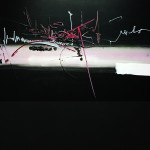Biography
The French painter Georges Mathieu (1921-2012) was a leading exponent of Art Informel (the French version of abstract expressionism), and is best-known for his spiky calligraphic-style abstract paintings characterized by sweeping gesturalist brushwork, as in Untitled (1959, Solomon R Guggenheim Museum, New York). Associated principally with the Lyrical Abstraction style, but also Tachisme, Mathieu’s expressive art, combined with a natural talent for self-promotion, gained him an international reputation during the 1950s. Curiously, Mathieu described himself not as a practitioner of non-objective art, but rather as a history painter using abstract forms. In any event, his signature style has made him one of the most recognizable 20th-century painters within the Art Informel idiom.
Born in Boulogne, in northern France, Mathieu studied law and philosophy before starting to paint in 1942. Largely self-taught as an artist, in 1947 he moved to Paris where he worked for American Express during the day, and painted during the evenings and weekends, in a rented studio near the Palais Luxembourg. Also in 1947 he helped launch the lyrical abstraction mode of painting by organizing the Paris exhibition entitled “Abstraction Lyrique”. The organic shapes of the exhibited works contrasted with the geometric style of concrete art found in traditional abstract painting.
Mathieu’s own early work featured a number of large canvases with coloured scrolls, whorls and other motifs painted on a black background. Subsequently, he changed his background to white, upon which he painted simple geometrical forms. In the 1950s he showed fifty of these paintings at the Leicester Galeries in London. Mathieu’s gestural style was influenced by several people, including the Tachiste Hans Hartung (1904-89), the American Jackson Pollock (1912-56), inventor of action painting, and the members of the Gutai Art Association, (1954–72) in Japan. (NOTE: For a different style of gesturalism, see: Jackson Pollock’s paintings 1940-56.)
A natural self-publicist, Mathieu painted many of his pictures during public performances, typically applying the paint directly from the tube onto the canvas. At the height of his career, Mathieu was one of France’s most successful painters, and in 1974 was the subject of a documentary film, Georges Mathieu, or the Fury of Being. His work was included in the Guggenheim’s 2012 exhibition “Art of Another Kind: International Abstraction and the Guggenheim, 1949-1960.”

 Lothaire Sort Secretment De Leon
Lothaire Sort Secretment De Leon